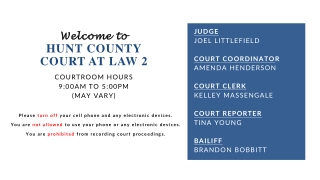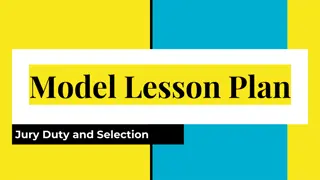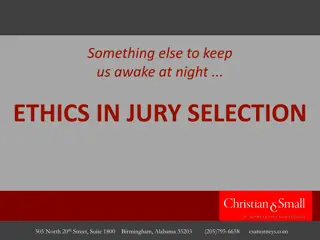Understanding the Dynamics of Jury Decision-Making in Game Theory
Delve into the intricate world of jury decision-making through the lens of game theory. Explore how jurors interpret evidence, consider pivotal moments, and weigh the costs of convicting an innocent versus acquitting a guilty individual. Witness the complexities of a Bayesian game as jurors navigate through scenarios of guilt and innocence, revealing strategic choices and preferences in the pursuit of justice.
Download Presentation

Please find below an Image/Link to download the presentation.
The content on the website is provided AS IS for your information and personal use only. It may not be sold, licensed, or shared on other websites without obtaining consent from the author. Download presentation by click this link. If you encounter any issues during the download, it is possible that the publisher has removed the file from their server.
E N D
Presentation Transcript
EC941 - Game Theory Lecture 4 Prof. Francesco Squintani Email: f.squintani@warwick.ac.uk 1
Structure of the Lecture Juries and Information Aggregation Auctions with Private Information 2
Juries In a trial, jurors are presented with evidence on the guilt or innocence of a defendant. They may interpret the evidence differently. Each juror votes either to convict or acquit the defendant. A unanimous verdict is required for conviction: the defendant is convicted if and only if every juror votes to convict her. 3
In deciding how to vote, each juror considers the costs of convicting an innocent person and of acquitting a guilty person, on the basis of her information. When voting, she conditions her choice on being pivotal, i.e. changing the outcome of the trial. The event of being pivotal is informative: It gives the juror information about the private information held by the other jurors, as this determines their votes. 4
A Model of Jury Vote Each juror comes to the trial with the belief that the defendant is guilty with probability . Given the defendant s status (guilty or innocent), each juror receives a signal. The probability that the signal is guilty when the defendant is guilty is p, and the probability that the signal is innocent if the defendant is innocent is q. Jurors are likely to interpret the evidence correctly: p > 1/2 and q > 1/2, and hence p > 1 q. 5
Each juror wishes to convict a guilty defendant and acquit an innocent one. Each juror s payoffs are: z if innocent defendant convicted (1 z) if guilty defendant acquitted. 0 if an innocent defendant is acquitted, or if a guilty defendant is convicted. 6
Let r be the probability of the defendants guilt, given a juror s information. Her expected payoff if the defendant is acquitted is and her expected payoff if the defendant is convicted is r(1 z) + (1 r) 0 = r(1 z) r 0 (1 r)z = (1 r)z. She prefers the defendant to be acquitted if r < z, and convicted if r > z. 7
Bayesian Game of Jury Vote Players The set of n jurors. States The states are the set of all profiles (X, s1, . . . , sn) where X {G, I} and sj {g, b} for every juror j. X = G if the defendant is guilty, X = I if she is innocent. si= g if player i receives the signal guilty, si = b if player i receives the signal innocent. 8
Strategies The set of strategies of each player is v = {C, Q}, where C is voting to convict, and Q is voting to acquit. Types Each player i s type consists in a signal si together with the set of all profiles (X, s-i), where s-idenotes i s opponents signals. 9
Beliefs Type g of a player i believes that the state is (G, s1, . . . , sn) with probability pk 1(1 p)n-k and (I, s1, . . . , sn) with probability (1 )qk 1(1 q)n-k, where k is the number of players j (including i) with sj=g. Type b believes that the state is (G, s1, . . . , sn) with probability pk(1 p)n-k-1 and (I, s1, . . . , sn) with probability (1 )qn-k-1(1 q)k, where k is the number of players j for whom sj = g. 10
Payoff functions The payoff function of each player i is: ui(v, X) = 0 if v = (C,...,C) and X=I or if v = (C,...,C) and X=G, ui(v, X) = z ui(v, X) = (1 z) where X is the first component of the state, giving the defendant s true status. if v = (C,...,C) and X = I if v = (C,...,C) and X = G, 11
Bayesian Nash Equilibrium One juror Suppose there is a single juror with signal b. To see if she prefers conviction or acquittal, we find the probability Pr(G|b) that the defendant s is guilty. By the Bayes Rule: Pr(G|b) = Pr(b|G)Pr(G)/[Pr(b|G)Pr(G)+Pr(b|I)Pr(I)] = (1 p) /[(1 p) + q(1 )]. The juror votes Acquittal if and only if z (1 p) / [(1 p) + q(1 )]. 12
Suppose there are n jurors. We show that truthful voting is not a Bayesian Equilibrium. Suppose by contradiction that every juror other than 1 votes truthfully (acquit if her signal is b, convict if it is g). Consider type b of juror 1. Her vote has no effect on the outcome unless every other juror s signal is g. Hence, she votes Acquittal if the probability Pr(G|b,g,..., g) that the defendant is guilty, given juror 1 s signal is b and every other juror s signal is g, is at most z. 13
Specifically, Pr(G|b,g,...,g) = Pr(b,g,...,g|G)Pr(G) /[Pr(b,g,...,g|G)Pr(G)+Pr(b,g,...,g|I)Pr(I)] =(1 p)pn-1 /[(1 p) pn-1 + q(1 q) n-1(1 )]. Hence, type b of juror 1 optimally votes for acquittal if z (1 p)pn-1 /[(1 p)pn-1 +q(1 q)n-1(1 )] = 1 /{1 +q/(1 p) [(1 q )/p]n-1 (1 )/ }. Hence, unless z is large or n is small, voting truthfully is not a Bayesian Nash Equilibrium. 14
Under some conditions there is a symmetric mixed strategy equilibrium in which each type g juror votes for conviction, and each type b juror randomizes. Denote by the mixed strategy of each juror of type b. Each type b juror is indifferent between voting conviction and acquittal. Hence the mixed strategy is such that: z = Pr(G | signal b,n 1 votes for C) 15
Pr(b|G)(Pr(vote C| G))n1Pr(G) z= Pr(b|G)(Pr(vote C|G))n 1Pr(G)+Pr(b|I)(Pr(vote C|I))n 1Pr(I) (1 p)(p+(1 p) ) n 1 (1 p)(p+(1 p) )n 1 +q(1 q+q ) n 1(1 ) The condition that this probability equals z implies (1 p)(p+(1 p) )n 1 (1 z) = q(1 q + q )n 1(1 )z. hence: where X = { (1 p)(1 z)/[(1 )qz]}1/(n-1). = [pX (1 q)] /[ q (1 p)X], 16
When n is large, X is close to 1, and hence nears 1: a juror who interprets the evidence as pointing to innocence very likely nonetheless votes for conviction. An interesting property of this equilibrium is that the probability that an innocent defendant is convicted increases as n increases: the larger the jury, the more likely an innocent defendant is to be convicted. I.e., Pr(C,n|I) = {1 (1- )(1-q)}n increases in n. 17
First-Price Auctions In a sealed-bid second price auction, the winner pays a price equal to second-highest bid. In the case of complete information, this auction is strategically equivalent to the English auction. In a sealed-bid first price auction, the winner pays a price equal to her bid. This auction is equivalent to a Dutch auction. 18
In a Dutch auction, the ask price for a good is decreased until the one bidder accepts to buy. Under complete information, strategic choices are equivalent in second-price auctions and Dutch auctions. Each bidder decides, before bidding begins, the most she is willing to bid. To win, a bidder needs to bid the highest bid, and will pay a price equal to her bid. 19
First-Price Auction Game Players: n bidders. Bidder i s valuation is vi, we order v1> > vn > 0, without loss of generality. Strategies: bidder i s maximal bid is bi. Let bi = max {bj : j different from i}. Payoffs: ui(b1, ,bn) = vi - bi if bi > bi 0 if bi < bi 20
Nash Equilibrium One N.E. is: (b*1, , b*n) = (v2, v2, , vn). Bidder 1 wins the object, payoff: v1 - b*1 = v1 - v2 > 0. If bidding b1 < v2, she loses the object, the payoff is 0. If bidding b1 > v2, her payoff is v1 - b2 < v1 - v2 . The payoff of bidders i = 2, , n is 0. If bidding bi > vi, the payoff is vi - bi < 0. If bidding bi < v2, she loses the object, the payoff is 0. 21
There are many other Nash Equilibria. In all equilibria, the winner has the highest valuation. Take any profile (b1, ..., bn) such that player i = 1 wins. If bi > vi, then i s payoff is negative, i can improve her payoff by bidding zero. If bi < vi, then player 1 can increase her payoff from zero to v1 - bi - >0 by bidding bi + . 22
Auction and Private Information We use Bayesian games to model auctions in which bidders do not know each others valuations. If each bidder i s type is simply her valuation vi, we say that the bidders values are private. If each bidder s valuation depends also on other bidders types, we say that values are common. (E.g., auctions for natural resources exploitation rights). 23
Second Price Auctions with Private Values Players: n bidders. Types: Each bidder i s type is her valuation is vi. Strategies: bidder i s maximal bid is bi. Payoffs: ui(b1, ,bn, v) = vi - bi where, bi = max {bj : j different from i}. if bi > bi if bi < bi 0 24
The profile (b*1, , b*n) = (v1, , vn) is the unique weakly dominant solution. Although valuations are now private information, the unique weakly dominant solution is the same as in the complete information case. The proof is entirely analogous to the case of complete information. 25
Weakly Dominant Solution The strategy profile (b*1, , b*n) = (v1, , vn) is the unique weakly dominant solution. bi < bi < vior b < bi or bi > vi bi=bi & i loses bi =bi & i wins vi - bi 0 0 bi < vi bi = vi vi - bi vi - bi 0 26
bi > bior bi =bi & i loses vi < bi < bior bi =bi & i wins bi < vi bi = vi vi - bi 0 0 bi > vi vi - bi vi bi (< 0) 0 In sum, bidding bi = vi yields at least as high a payoff as bidding bi > vi or bi < vifor any opponents bids. 27
First Price Auctions with Private Values Players: n bidders. Types: each bidder i s type is her valuation vi. Strategies: bidder i s maximal bid is bi. Payoffs: ui(b1, ,bn, v) = vi - bi where, bi = max {bj : j different from i}. if bi > bi if bi < bi 0 28
Nash Equilibrium Say that each vi is independently drawn from a strictly increasing and differentiable cumulative distribution function F, with F(v-) = 0 and F(v+) = 1. Focus equilibria with strategies that are differentiable, increasing in the type, and symmetric across players. To find the equilibrium, first find conditions satisfied by the players best response functions, and then impose that strategies are best response to each other. 29
Denote the bid of type vi of player i by (vi). The expected payoff of a player of type v who bids bid b when every other player s strategy is is (v-b)Pr{All other bids < b} = (v-b)F( -1(b))n-1. To find the best response when every other player s strategy is , we take the first-order conditions -F( -1(b))n-1 +(v-b)(n-1) F( -1(b))n-2 F ( -1(b))/ ( -1(b))=0 30
For (,... , ) to be a Nash equilibrium, the bid (v) must be the best response for every type of v, when every other player adopts the strategy I.e., the bid b = (v) must satisfy the previous first order conditions. Hence, the equilibrium condition is, for all v: -F(v)n-1 +(v- (v))(n-1)F(v)n-2 F (v)/ (v)=0 or F(v)n-1 (v)+ (v)(n-1)F(v)n-2 F (v)=v(n-1)F(v)n-2 F (v). 31
Integrating both sides of the differential equation, v F(v)n-1 (v)= x(n-1)F(x)n-2 F (x) dx. v- Integrating by parts the right hand side, v F(v)n-1 (v) = - F(x)n-1 dx + vF(v)n-1. v- We verify that (v) is increasing: ( , , ) is B.N.E., v (v) = v- F(x)n-1 dx/F(v)n-1. v- 32
Revenue Equivalence Suppose that n risk neutral bidders compete in a sealed- bid auction, in which the highest bidder wins the good. (These auctions include first-price auctions, second- price auctions, all-pay auctions, etc.). Suppose that each bidder independently receives a signal from the same continuous and increasing cumulative distribution, and has a valuation that depends continuously on all the bidders signals. 33
Consider any symmetric Nash equilibrium with differentiable, increasing strategies, and such that the expected payoff of a bidder with the lowest possible valuation is zero. Given the opponent s equilibrium strategies, each player s bid affects her winning probability p and expected equilibrium payment e(p). So, we can think of each bidder s equilibrium bid choice as just choosing a value of p. 34
The problem of a bidder with valuation v is: maxp pv - e(p) Let the solution be p*(v), the first-order condition gives v = e (p*(v)) for all v. Integrating both sides of this equation, we have e(p*(v)) = e(p*(v-)) + x dp*(x). v v- 35
Because the good is sold to the bidder with the highest valuation, p*(v) = Pr{vj < v, for n-1 bidders j}= Pr(X<v), where X is the highest of n-1 independent valuations. The probability of winning is independent of the detailed rules of the auction. Because the expected payoff of a bidder with valuation v- is zero, e(p*(v-)) = 0; hence, the expected payment of any player of type v is e(p*(v)) = Pr(X<v)E[X|X<v], independently of the detailed rules of the auction. 36
We obtain the following result. Theorem (Revenue Equivalence Principle). Suppose that each bidder (i) is risk neutral, (ii) independently receives a signal from the same continuous and increasing cumulative distribution, and (iii) has a valuation that depends continuously on all the bidders signals. Consider auctions in which the highest bidder wins the good. Consider any symmetric Nash equilibrium with increasing strategies, and such that the expected payoff of a bidder with the lowest possible valuation is zero. The expected payment of a bidder of any given type is the same regardless of the auction rules, and hence also the auctioneer s expected revenue is the same. 37
Summary of the Lecture Juries and Information Aggregation Auctions with Private Information 38
Preview of the Next Lecture Definition of Extensive-Form Games Subgame Perfection and Backward Induction Applications: Stackelberg Duopoly, Harris-Vickers Race. 39























